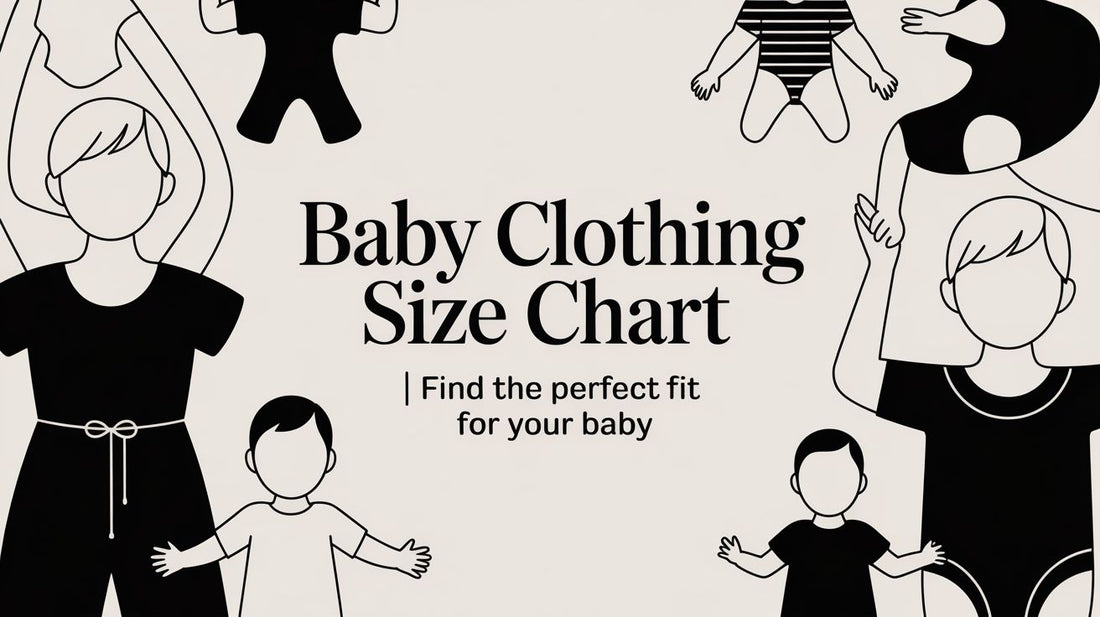
Baby Clothing Size Chart | Find the Perfect Fit for Your Baby
Share
Shopping for baby clothes can feel like a guessing game. Labels like "0-3 Months" seem straightforward, but as any parent will tell you, they're more of a suggestion than a hard rule. A baby clothing size chart is your secret weapon, helping you translate those tags into real-world measurements based on your baby's unique weight and height.
Your Quick-Reference Baby Clothing Size Chart
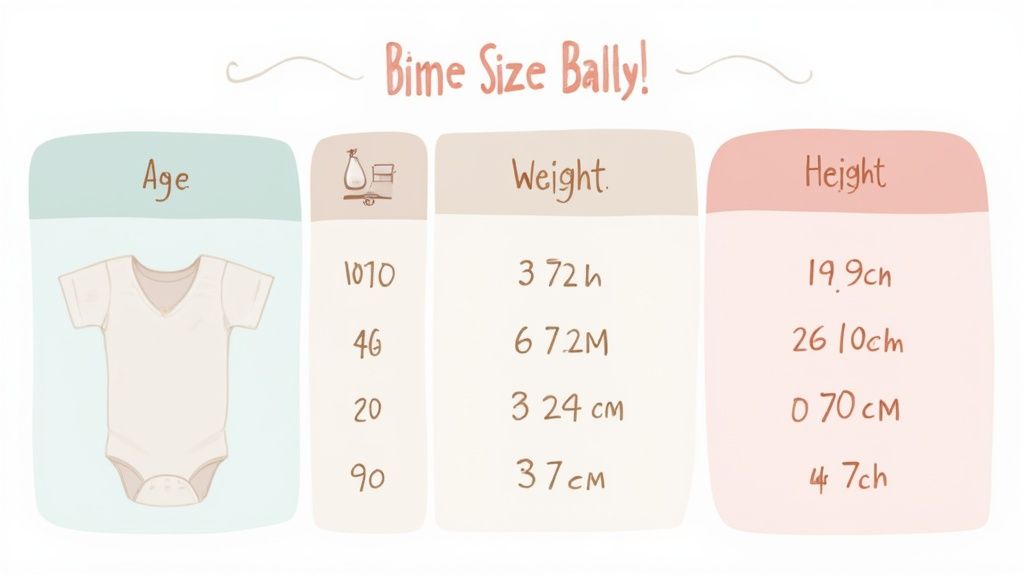
Lost in a sea of tiny onesies and sleepers? You're not alone. It's a classic new-parent surprise: the age on the clothing tag rarely matches your baby's actual age. You might have a super-cuddly three-month-old who's already rocking 6-9 month outfits, or a petite six-month-old who is still perfectly comfortable in 3-6 month sizes.
This is exactly why a baby clothing size chart is a lifesaver. It cuts through the confusion and helps you shop based on what truly matters—your baby's current measurements.
Why Weight and Height Matter Most
Forget the age on the tag for a second. The most reliable way to get the right fit is by looking at your baby's weight and height. These numbers give you a far more accurate picture than their age, because every baby grows at their own pace.
If you're an expecting parent trying to build that first wardrobe, our newborn clothing essentials list is a great place to start. It’s packed with practical advice on what you'll actually use.
A quick pro-tip I always share with new parents: if your baby is between two sizes, always go for the bigger one. It gives them some much-needed room to grow and ensures their clothes aren't tight or restrictive while they're wiggling around.
Standard Baby Clothing Size Quick Reference
Here’s a straightforward table that breaks down the standard U.S. baby sizes. Think of this as your go-to reference for quick shopping decisions.
| Size Label | Age Range | Weight (lbs) | Height (in) |
|---|---|---|---|
| Preemie (P) | Up to Birth | Up to 6 lbs | Up to 17 in |
| Newborn (NB) | 0-1 month | 6-9 lbs | 17-21 in |
| 0-3 Months | 0-3 months | 9-12.5 lbs | 21-24 in |
| 3-6 Months | 3-6 months | 12.5-17 lbs | 24-27 in |
| 6-9 Months | 6-9 months | 17-21 lbs | 27-28 in |
| 9-12 Months | 9-12 months | 21-25 lbs | 28-30 in |
| 12-18 Months | 12-18 months | 25-28 lbs | 30-32 in |
| 18-24 Months | 18-24 months | 28-30 lbs | 32-34 in |
Keep this chart handy, but remember it's a starting point. Later in this guide, we'll dive into how different brands and international sizing can vary, so you'll be prepared for anything.
How to Measure Your Baby for the Perfect Fit
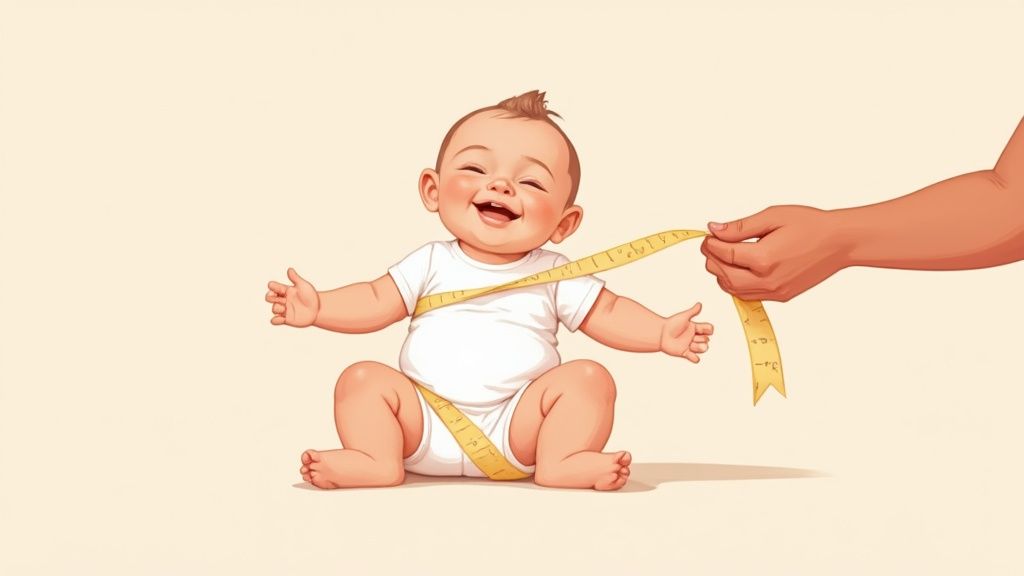
Let's be honest—the age on a clothing tag is more of a suggestion than a rule. Babies grow at their own speed, so relying on "3-6 months" can be a total crapshoot. The secret to getting that perfect, comfy fit every single time? Taking your baby's actual measurements.
Getting a wriggly baby to cooperate for measurements sounds like a mission, but it's much easier than you'd think with a few simple tricks. All you need is a soft, flexible measuring tape, like the kind used for sewing. For the most accurate numbers, try to measure when they're just in their diaper, without any bulky clothes getting in the way.
Taking Your Baby’s Measurements
There are really only three measurements that matter for most clothes: height (or length), chest, and weight. These are the big three that nearly every brand bases their baby clothing size chart on.
Here’s how to get them:
-
Height (Length): The easiest way is to lay your baby down on a flat, soft surface. Gently straighten out their little legs and measure from the very top of their head to the bottom of their heel. If you've got a squirmy one, grabbing a partner to help keep them steady can make this a two-second job.
-
Chest: Gently wrap the measuring tape around the fullest part of your baby’s chest, right up under their armpits. You want it to be snug, but not tight—you should be able to slide a finger underneath.
-
Weight: A dedicated baby scale will give you the most precise number. No baby scale? No problem. Just hop on your regular bathroom scale while holding your baby, then weigh yourself alone. The difference between those two weights is your baby's weight.
Comparing to a Size Chart
With those three numbers in hand, you're ready to tackle any size chart with confidence. The golden rule: if your baby’s measurements are between two sizes, always choose the larger size. It gives them room to move and wiggle, and it'll last through that inevitable overnight growth spurt.
Pro Tip: Pay attention when measurements span different size categories. For example, if your baby’s weight fits a 3-6 month size but their length is in the 6-9 month range, go with the bigger size. This is especially true for one-pieces like sleepers and rompers where a little extra length makes all the difference for comfort.
A Comprehensive Baby Clothing Size Chart By Age And Weight
Alright, you've got your baby's measurements. Now for the fun part: turning those numbers into a closet full of perfectly fitting, adorable outfits. This is your master list, the detailed breakdown that goes beyond a quick glance. Think of it as your go-to reference for everything from those teeny-tiny preemie bodysuits to clothes for your little one who's just about to start toddling.
We’ll dig into the details that often trip parents up, like the classic "Newborn" versus "0-3 Months" dilemma. This baby clothing size chart is designed to grow with your baby, helping you confidently plan their next wardrobe update before they have a growth spurt overnight.
Decoding Newborn vs 0-3 Months Sizes
One of the first puzzles new parents face is the "Newborn" size tag. The best way to think of it is as a short-term, in-between stage. Newborn (NB) sizes are specially made for brand-new babies, typically those weighing between 6-9 pounds, and they are perfect for those first few precious weeks.
Here's the catch, though: many babies either outgrow this size in a flash or skip it entirely if they arrive weighing over 9 pounds! That’s where the "0-3 Months" size comes in. It offers a little more wiggle room, fitting babies from about 9 to 12.5 pounds. If you're buying a gift or trying to stock up before your little one arrives, grabbing 0-3 months items is usually the safer bet for getting more wear out of them.
The Master Chart: US vs International Sizes
Once you start shopping, especially online, you’ll quickly discover a whole world of adorable brands from different countries. But with that comes a whole new set of sizing systems. European sizes, for example, are usually based on a baby's height in centimeters, while UK sizes have their own unique scale. It can feel like learning a new language.
This handy infographic helps visualize how the average baby's weight lines up with standard US sizes during their first six months.
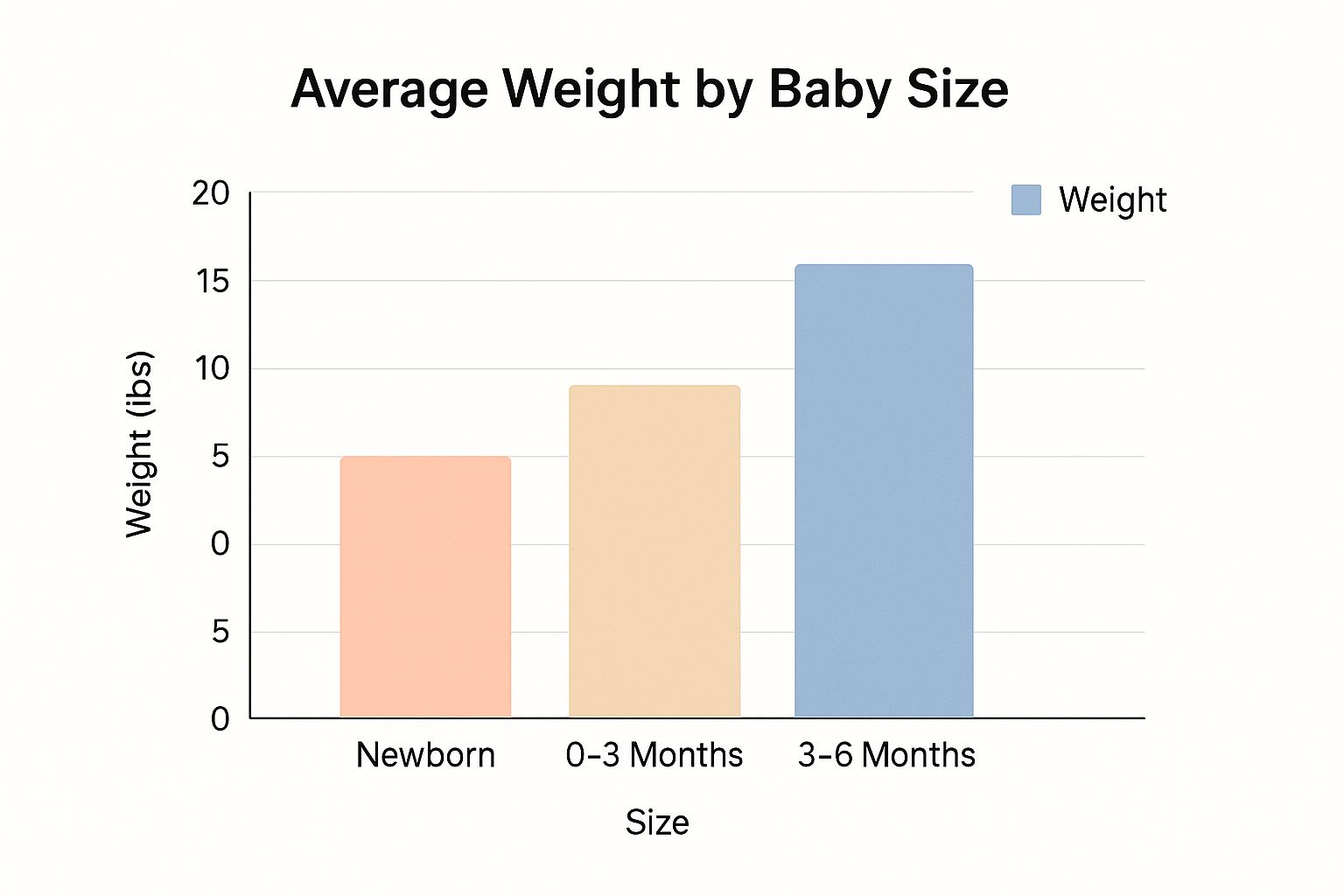
As you can see, the weight range for each size is pretty significant, which is exactly why weight is a much more reliable guide than age alone.
It's no secret that babies grow at a mind-boggling speed, and international sizing really highlights this. A European size 60 usually fits a 3–6 month old (12–16 pounds), but by the time they hit 6–12 months (16–20 pounds), they’re already in a size 70. This fast-paced growth is why it feels like you're constantly buying new clothes just to keep up! For a deeper dive, check out our ultimate guide to baby clothes sizes.
To make things easier, I've put together a table to help you quickly translate sizes between the US, UK, and Europe.
Comprehensive Baby Size Chart US vs EU vs UK
This table is your quick-reference tool for comparing baby clothing sizes across the US, UK, and European standards. Just find the size you know and look across the row to see its international equivalent, along with the typical age, weight, and height measurements for that size.
| US Size | UK Size | European Size | Typical Age | Weight (lbs/kg) | Height (in/cm) |
|---|---|---|---|---|---|
| Preemie | Up to 1 month | 44 | Up to Birth | Up to 6 lbs / 2.7 kg | Up to 17" / 43 cm |
| Newborn | Up to 1 month | 50 | 0-1 month | 6-9 lbs / 2.7-4 kg | 17-21" / 43-53 cm |
| 0-3 Months | 0-3 months | 56 | 0-3 months | 9-12.5 lbs / 4-5.7 kg | 21-24" / 53-61 cm |
| 3-6 Months | 3-6 months | 62 | 3-6 months | 12.5-17 lbs / 5.7-7.7 kg | 24-27" / 61-69 cm |
| 6-12 Months | 6-12 months | 74 | 6-12 months | 17-25 lbs / 7.7-11.3 kg | 27-30" / 69-76 cm |
| 12-18 Months | 12-18 months | 80 | 12-18 months | 25-28 lbs / 11.3-12.7 kg | 30-32" / 76-81 cm |
| 18-24 Months | 18-24 months | 86 | 18-24 months | 28-30 lbs / 12.7-13.6 kg | 32-34" / 81-86 cm |
Remember, this chart is a fantastic starting point, but always be prepared for a little variation between brands. When in doubt, sizing up is almost always the best move
Sizing Different Types Of Baby Clothes
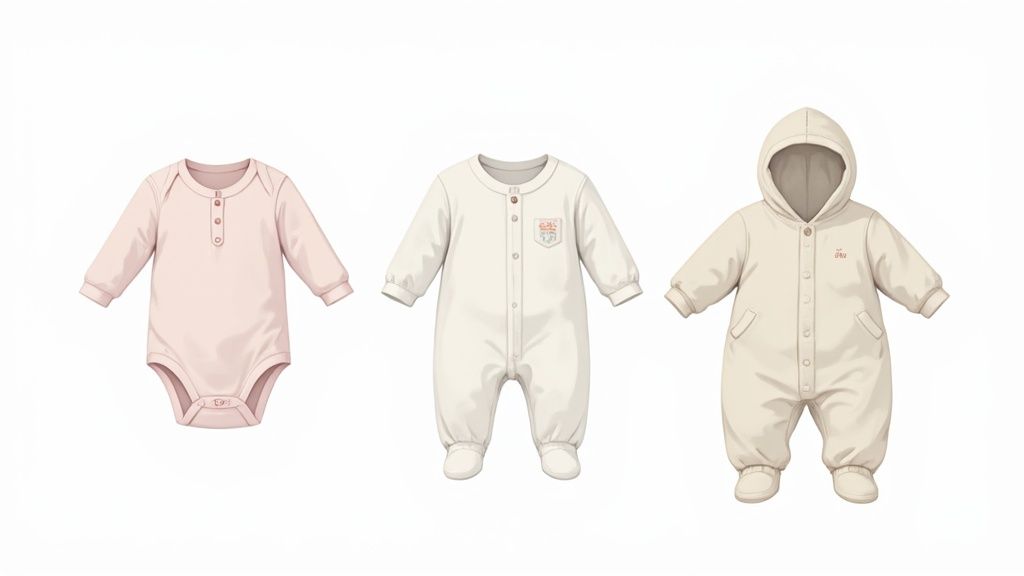
You’ve probably already discovered that a "3-6 Months" tag on a stretchy bodysuit fits way differently than the same size on a bulky winter coat. It’s not just you! The type of clothing makes a huge difference in how it’s designed to fit, and getting a handle on these nuances is the secret to a comfy and practical wardrobe for your little one.
Think about it: a basic onesie is meant to be snug, almost like a second skin, while a jacket needs room for all the layers you’ll pile on underneath. This is exactly why you can't just go by the age on the tag. The whole purpose of the garment shapes its cut and fit, a detail that’s super important to remember when you're looking at a baby clothing size chart.
Sleepwear And Safety
When you’re shopping for baby PJs, you'll see the term "snug-fitting" on just about every tag. This isn’t a style suggestion—it’s a non-negotiable safety feature. Loose-fitting sleepwear is considered a fire risk, so safety standards demand that it’s either treated with flame retardants or fits snugly to reduce the amount of air between the fabric and your baby's skin.
This is why you might notice that a pair of 6-12 month pajamas looks a lot narrower than a daytime romper in the exact same size. For sleep, always go with that snug fit and resist the urge to size up too much in their sleepwear.
Sleep sacks and swaddles are another bedtime essential. Their warmth is measured by a TOG rating, not by thickness. To make sure your baby stays at the perfect temperature all night, it's worth taking a look at our guide on what TOG means for baby sleepwear.
Outerwear And Layering
Dressing a baby for chilly weather is a whole different ball game. For things like jackets, snowsuits, or those adorable fleece buntings, it’s almost always a good idea to size up. This isn’t just about getting a little more wear out of an expensive item; it's about making sure there's enough room for their regular clothes underneath without them feeling like a stuffed sausage.
Here are a few quick tips for getting outerwear right:
- Go One Size Up: As a general rule, if your baby is fitting well into 3-6 month clothes, grab a jacket in the 6-9 month or 6-12 month range.
- Do a Sleeve Check: The sleeves should be long enough to cover their wrists, but not so long that their little hands get completely swallowed up.
- Remember Car Seat Safety: Be careful with puffy snowsuits and thick jackets in the car seat. They can compress in a crash and make the straps too loose to be safe. Opt for thinner, warm layers and a car seat-safe poncho or a cozy blanket draped over the top instead.
So, Why Do Baby Clothing Sizes Vary So Much Between Brands?
Ever held up two "6-month" onesies from different brands and thought, "There's no way these are the same size"? You're not going crazy. The main reason for this sizing mess is that there are no legally required or universal sizing standards for baby clothes in the United States.
It’s a bit of a free-for-all. Each brand develops its own baby clothing size chart, and their idea of an "average" baby can be completely different from the next company's. One brand might design its clothes for a longer, leaner baby, while another caters to a shorter, chubbier build. This is why a "3-6 Months" outfit from one store might fit more like a "6-9 Months" from another.
It's Not Just the Chart—It's the Fabric and Fit
Beyond the numbers on the chart, the actual material makes a huge difference in how an outfit fits and feels.
- Stretchy Knits: Think bamboo viscose or soft cotton jersey. These fabrics have a ton of give, which means the fit is more flexible and can often last through a growth spurt. It's no surprise that many of the best organic baby clothes brands lean heavily on these comfy, forgiving materials.
- Woven Fabrics: On the other hand, materials like denim or corduroy have almost no stretch. Clothes made from wovens need to be cut with more precision, and the sizing has to be spot-on, or they’ll feel too tight.
This sizing inconsistency is becoming even more common as the baby apparel market expands, especially in the premium space. With the global market projected to hit $9.15 billion in 2025, high-end brands are trying to stand out with their own unique fits and styles, adding even more variation to the mix.
The Takeaway: Your best bet is to ignore the age on the tag and always check the brand’s specific weight and height chart. If you're still not sure, take a peek at recent customer reviews—parents are usually quick to share whether a brand runs big or small.
Practical Tips For Buying The Right Size
Figuring out baby clothes can feel like a guessing game, but it doesn't have to be. With a few simple tricks up your sleeve, you can look at any baby clothing size chart and feel confident you're picking the right thing. These tips will help you save a little money, cut down on returns, and most importantly, keep your baby comfy.
The number one rule? Go by your baby's current weight and height, not the age on the tag. Every baby grows on their own schedule. You might have a lanky three-month-old who needs 6-9 month PJs for the length, or a smaller six-month-old who's still perfectly happy in 3-6 month outfits. Always check the specific brand's chart before you buy.
Master Your Shopping Strategy
A little planning makes all the difference. Since babies seem to grow overnight, it's always a good idea to buy one size ahead. Having the next size up ready to go means you won't be scrambling for clothes after a sudden growth spurt.
Pay attention to the fabric, too. Stretchy materials like bamboo viscose or soft cotton blends have a lot more give and can last through a growth spurt much better than stiff fabrics like denim. Also, look for clever features like foldable cuffs or an extra row of snaps—they can help you get a few more weeks or even months out of a garment.
Smart Shopper's Checklist
- Check the Return Policy: Before you click "buy," especially online, double-check the store's return policy. A flexible policy is your best friend when a size just doesn't work out.
- Account for Shrinkage: Natural fabrics, especially cotton, are notorious for shrinking a bit in the wash. If your baby is right on the edge of two sizes, sizing up is usually the safer move.
- Read Recent Reviews: Other parents are your best resource. Scan the reviews to see what people are saying—they'll often mention if an item runs big, small, or true to size.
Plan for Function and Comfort
Think about how your baby will actually wear the item. For something like a jacket or snowsuit, you'll almost always want to go one size up to leave plenty of room for layers underneath. On the other hand, sleepwear should always be snug for safety. For more on that, check out our guide on how to dress a baby for sleep.
Getting the fit right is a big deal, and it’s a huge part of the global baby apparel market, which is worth around $227 billion in 2024. Brands know that parents need options, so they offer clothes sorted by size, age, and style to make sure there's a perfect fit for every baby and every occasion. You can learn more about the growing baby clothing market if you're curious
Frequently Asked Questions About Baby Clothes Sizes
Even with a perfect baby clothing size chart in hand, a few questions always seem to pop up. Let's walk through some of the most common ones I hear from parents. Hopefully, this will clear up any confusion and turn you into a sizing pro.
What Does The T Mean In Sizes Like 2T?
So, you've conquered the "24 Months" size, and now you're seeing "2T." What's the deal? That "T" simply stands for Toddler.
While the height and weight recommendations for a 24-month and a 2T outfit look almost identical, the real difference is in the cut. Toddler sizes are designed to be a bit slimmer and longer. They're made for a kid who's up and running around, with a more upright, active posture. Infant sizes, on the other hand, are typically wider to make room for a diaper-fluffed bottom and a round baby belly.
Should I Wash Baby Clothes Before They Wear Them?
Oh, absolutely. The answer here is a big yes. I always recommend washing new clothes before putting them on your baby.
Think about it—those tiny outfits have been through a lot during manufacturing and shipping. A quick wash helps get rid of any dust, leftover chemicals, or potential irritants that could upset your baby’s super-sensitive skin. Just toss them in with a gentle, baby-safe detergent, and you're good to go.
How Many Outfits Do I Need In Newborn Size?
This is the million-dollar question, and it's tough because every baby's journey is unique. The Newborn (NB) size is generally made for babies between 6-9 pounds. But some little ones arrive bigger than that, and others hit a growth spurt and fly through this size in a matter of weeks.
As a general rule of thumb, I'd suggest having 5-7 easy, comfortable Newborn outfits on hand. Think zip-up sleepers and side-snap onesies—anything that makes those frequent changes easier. This should be enough to handle a couple of days' worth of spit-up and diaper messes without you buying a whole wardrobe they'll barely wear.
Do Baby Clothes Shrink After Washing?
They sure can! Fabrics like 100% cotton are especially known for shrinking a bit in the wash. If you're buying a cotton piece and your baby is right on the edge of the next size, do yourself a favor and size up.
You can help minimize the shrinkage by washing in cold water and drying on a low heat setting. Still, it's always smart to plan for a little bit of shrinkage so their clothes don't get too tight after that first laundry day.
At Little Venture Co., we get it. We design our bamboo sleepwear and daywear to move and grow with your baby. Our ultra-soft, stretchy fabrics offer a flexible, lasting fit, wrapping your little one in faith-inspired comfort. Feel free to explore our collection today to find the perfect fit.
